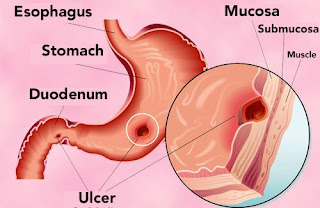Top Five Foods for Stomach Ulcer Patients
Peptic ulcers are wounds that occur in the human lower throat (oesophagus), intestine
and stomach. Peptic ulcers are often caused by Helicobacter pylori
bacteria. Stomach ulcer common signs are upper abdominal pains, belching,
weight loss, poor appetite, and vomiting. The abdominal pain is always
characterized by a dull ache. Some types of foods exacerbate peptic ulcers’
condition while others aid in its healing process. Therefore, people who are
suffering from stomach ulcers should strictly follow their diets. The following
foods help peptic ulcers’ healing process.
Whole
grains
Whole grains comprise of low fat and sugar but high fibre which speeds up the ulcer
healing process. Whole grains also contain zinc that aid in body’s healing
process. Foods that are high in fat spend a lot of time in the stomach, this
trigger voluminous production of hydrochloric acid that worsens peptic ulcer
conditions.
Fruits
and vegetables
- Fruits and vegetables like
cabbages, carrots, cabbage juice, grapes, kiwi fruit, and apricots have
ascorbic acid (vitamin C) and beta-carotene components that help in
protect stomach’s and intestines’ lining.
- Some fruits such as berries
have antioxidants that decrease the prevalence of peptic ulcers and lessen
the signs of existing stomach ulcers.
- Seaweeds produce
prostaglandins that guard the lining of intestines and stomach. Seaweeds
can be taken as powder form or capsules, however, its powder form works
well when it is added to foods as a seasoning.
- Sunflower seed oils,
soya-bean, hazelnuts, and wheat-germ have vitamin E which together with
zinc assists in stomach ulcer healing process.
- Sesame seeds, almonds,
cheddar cheese, seaweed, sunflower seeds and wheat germ contain a good
amount of amino acids that possesses body’s healing action.
Herbal
teas
Herbs
like peppermint, chamomile, and liquorice and marshmallow contain anti-inflammatory and anti-bacterial effects. These effects make fundamental in
ulcer healing process and hence make peptic ulcer patients feel comfortable.
Slippery
elm diets
Slippery
elm foods comprise of anti-inflammatory and antioxidant characteristics. They
have been clinically used to help people suffering from peptic ulcers. They are
precursors in the synthesis of vicious mucilage which lines the intestines and
stomach. It is recommended that one takes slippery elm foods before meals so
that they can protect the gut.
White
meats
White
meats from turkey, chicken or fish are just good for stomach ulcer patients.
Fish like herring, mackerel, sardines and salmon contain omega-3 fatty acids.
The omega-3 fatty acids release prostaglandins which protect intestines’ and
stomach’s lining. Omega oils possess eicosapentaenoic (EPA) and docosahexaenoic(DHA)
which are precursors in the synthesis of prostaglandins. Seed oil supplements,
cod liver oil, and krill oil contains large amounts of docosahexaenoic and
eicosapentaenoic, hence someone who cannot get access to white meats can use
them. Prostaglandins function in the same as the omeprazole which is always
prescribed for peptic ulcer patients to decrease excessive acids in the
stomach.
Managing
peptic ulcers needs the collaboration of different practices; however, one’s
correct diet has been effective and less expensive in controlling and treating
peptic ulcers for decades. Foods that cause the release of less hydrochloric
acid in the stomach during digestion are recommended for peptic ulcer patients.
Stomach ulcer patients should avoid eating a lot of foods since it stimulates
excessive production of hydrochloric acid in the stomach.






Nice post. Well what can I say is that these is an interesting and very informative topic on good bacteria in stomach
ReplyDelete